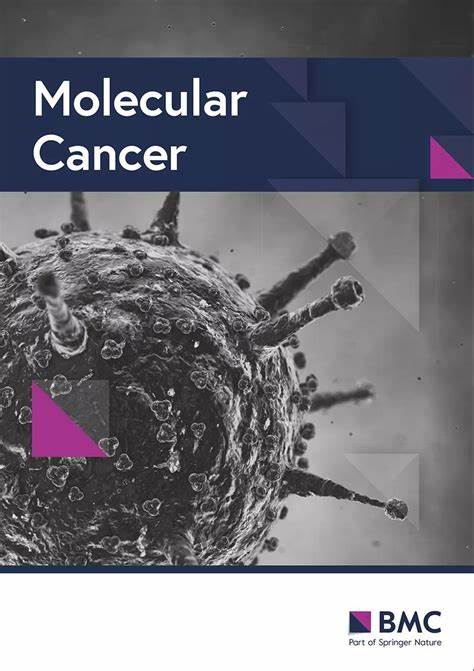工程氧化铁纳米平台:为精确癌症治疗重新编程免疫抑制利基
IF 33.9
1区 医学
Q1 BIOCHEMISTRY & MOLECULAR BIOLOGY
引用次数: 0
摘要
氧化铁纳米颗粒(IONPs)已经从传统的磁共振成像(MRI)造影剂转变为结构可编程的组合成像/治疗工具,利用其超顺磁性、催化活性和表面工程的多功能性来实现对药物传递和免疫调节的时空控制。纳米制造技术的进步现在产生了尺寸优化的聚集体,通过增强渗透性和滞留性(EPR)效应增强了肿瘤的积累,而临床批准的制剂如阿魏木糖醇(ferumoxytol)显示了内在的免疫调节功能,使IONPs成为精确肿瘤学的关键工具。相反,癌症免疫治疗仍然受到免疫抑制肿瘤微环境(TME)的限制,其中通过m2极化巨噬细胞和调节性T细胞(Tregs)进行的细胞抑制与密集细胞外基质的物理排斥和乳酸驱动的酸中毒代谢破坏协同作用。这些屏障建立了以CD8 + t细胞浸润不足和三级淋巴结构形成为特征的“免疫-冷”表型,在实体瘤中驱动检查点抑制剂耐药性,反应率低于30%。为了克服这些限制,IONPs协调了多模式免疫治疗策略:它们通过使巨噬细胞向M1表型极化来重编程抑制性生态位,激活STING通路,诱导免疫原性铁凋亡;通过磁性淋巴结靶向和癌细胞膜介导的同源肿瘤归巢实现精确递送;并通过监测免疫细胞运输的核磁共振/磁颗粒成像(MPI)促进实时治疗。临床前验证证实了协同效应,通过将免疫冷微环境转化为炎症状态,组合方案实现了50%以上的肿瘤完全消退。这篇综述系统地探讨了基于ionp的前沿创新——跨越免疫细胞工程、生物杂交系统和能量放大疗法——在局部肿瘤根除和全身抗肿瘤免疫之间建立了桥梁,同时批判性地评估了临床实施的转化障碍。本文章由计算机程序翻译,如有差异,请以英文原文为准。
Engineered iron oxide nanoplatforms: reprogramming immunosuppressive niches for precision cancer theranostics
Iron oxide nanoparticles (IONPs) have transitioned from conventional magnetic resonance imaging (MRI) contrast agents into structurally programmable combined imaging/treatment tools, leveraging their superparamagnetism, catalytic activity, and surface engineering versatility to achieve spatiotemporal control over drug delivery and immune modulation. Advances in nanofabrication now yield size-optimized aggregates with enhanced tumor accumulation through the enhanced permeability and retention (EPR) effect, while clinically approved formulations like ferumoxytol demonstrate intrinsic immunomodulatory functionality, positioning IONPs as pivotal tools for precision oncology. Conversely, cancer immunotherapy remains limited by the immunosuppressive tumor microenvironment (TME), where cellular suppression via M2-polarized macrophages and regulatory T cells (Tregs) synergizes with physical exclusion from dense extracellular matrices and metabolic sabotage through lactate-driven acidosis. These barriers establish “immune-cold” phenotypes characterized by deficient CD8⁺ T-cell infiltration and tertiary lymphoid structure formation, driving checkpoint inhibitor resistance with sub-30% response rates in solid tumors. To overcome these constraints, IONPs orchestrate multimodal immunotherapeutic strategies: they reprogram suppressive niches by polarizing macrophages toward M1 phenotypes, activate STING pathways, and induce immunogenic ferroptosis; enable precision delivery via magnetic lymph node targeting and cancer cell membrane-mediated homologous tumor homing; and facilitate real-time theranostics through MRI/magnetic particle imaging (MPI)-monitored immune cell trafficking. Preclinical validation confirms synergistic efficacy, with combinatorial regimens achieving over 50% complete tumor regression by converting immunologically cold microenvironments into inflamed states. This review systematically explores cutting-edge IONP-based innovations—spanning immune cell engineering, biohybrid systems, and energy-amplified therapies—that bridge localized tumor eradication with systemic antitumor immunity, while critically evaluating translational barriers for clinical implementation.
求助全文
通过发布文献求助,成功后即可免费获取论文全文。
去求助
来源期刊

Molecular Cancer
医学-生化与分子生物学
CiteScore
54.90
自引率
2.70%
发文量
224
审稿时长
2 months
期刊介绍:
Molecular Cancer is a platform that encourages the exchange of ideas and discoveries in the field of cancer research, particularly focusing on the molecular aspects. Our goal is to facilitate discussions and provide insights into various areas of cancer and related biomedical science. We welcome articles from basic, translational, and clinical research that contribute to the advancement of understanding, prevention, diagnosis, and treatment of cancer.
The scope of topics covered in Molecular Cancer is diverse and inclusive. These include, but are not limited to, cell and tumor biology, angiogenesis, utilizing animal models, understanding metastasis, exploring cancer antigens and the immune response, investigating cellular signaling and molecular biology, examining epidemiology, genetic and molecular profiling of cancer, identifying molecular targets, studying cancer stem cells, exploring DNA damage and repair mechanisms, analyzing cell cycle regulation, investigating apoptosis, exploring molecular virology, and evaluating vaccine and antibody-based cancer therapies.
Molecular Cancer serves as an important platform for sharing exciting discoveries in cancer-related research. It offers an unparalleled opportunity to communicate information to both specialists and the general public. The online presence of Molecular Cancer enables immediate publication of accepted articles and facilitates the presentation of large datasets and supplementary information. This ensures that new research is efficiently and rapidly disseminated to the scientific community.
 求助内容:
求助内容: 应助结果提醒方式:
应助结果提醒方式:


